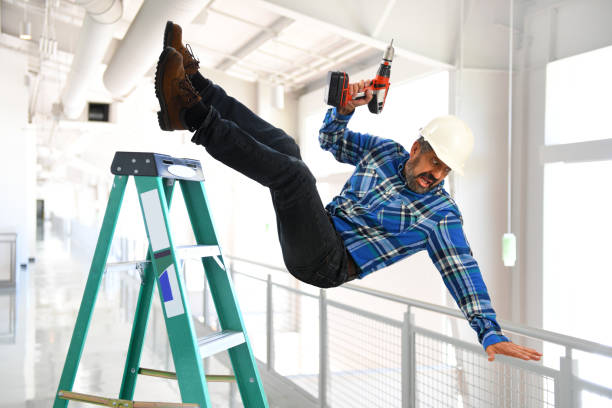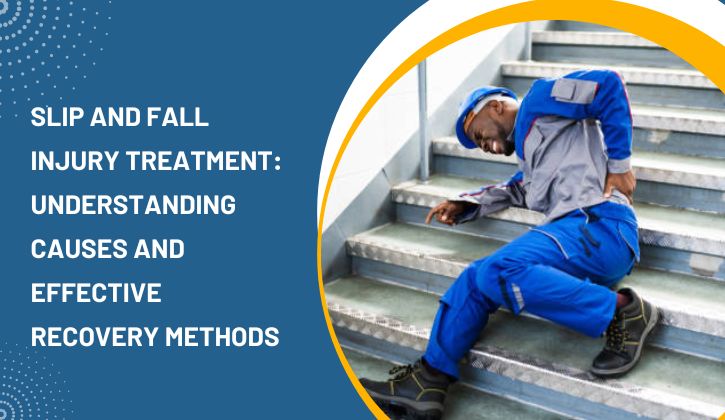Slip and fall accidents are common occurrences that can happen to anyone, anywhere. While many of these incidents result in minor bruises or embarrassment, others can lead to severe injuries that require immediate medical attention and proper treatment. In this blog post, we will explore slip and fall injury treatment options, focusing on understanding the causes of such accidents and the effective methods to promote a successful recovery.
Understanding Slip and Fall Injuries:
Slip and fall injuries can happen due to a variety of factors, including uneven surfaces, wet floors, poor lighting, and cluttered pathways. When a person loses balance and falls, it can lead to various injuries, such as:
- Sprains and strains: Twisting or wrenching movements during a fall can cause ligaments and muscles to stretch or tear.
- Fractures: The impact of a fall can result in broken bones, especially in the wrists, arms, hips, and ankles.
- Head injuries: A fall can cause concussions or more severe traumatic brain injuries (TBIs) if the head hits a hard surface.
Immediate Steps after a Slip and Fall:
If you or someone you know experiences a slip and fall accident, it’s crucial to take immediate steps to ensure safety and seek medical attention:
- Stay calm and avoid moving if you suspect severe injuries.
- Call for help or ask someone nearby to do so.
- Seek medical attention even if the injuries seem minor, as some injuries may not show immediate symptoms.
- Report the incident to the property owner or manager and request an accident report.
- Document the scene with photographs if possible.
Slip and Fall Injury Treatment Options:
Effective treatment for slip and fall injuries depends on the severity of the damage. Here are common treatment methods:
- Rest and immobilization: For fractures and severe sprains, immobilization through casts or splints may be necessary to promote healing.
- Pain management: Over-the-counter pain relievers or prescription medications can help manage pain and reduce inflammation.
- Physical therapy: A physical therapist can design a personalized rehabilitation plan to improve strength, flexibility, and balance.
- Surgery: In some cases of severe fractures or joint injuries, surgery may be required to restore proper function.
- Assistive devices: Crutches, canes, or walkers may aid mobility during the recovery process.
Rehabilitation and Recovery:
Recovering from a slip and fall injury takes time and dedication to the rehabilitation process. Here are some essential tips for a successful recovery:
- Follow medical advice: Adhere to your doctor’s instructions and attend all follow-up appointments.
- Gradual return to activities: Avoid pushing yourself too hard and gradually resume daily activities as advised by your healthcare provider.
- Focus on physical therapy: Engage in prescribed physical therapy exercises to regain strength, balance, and range of motion.
- Modify home environment: Make necessary modifications to your home to prevent future accidents, such as installing handrails and removing tripping hazards.
- Seek emotional support: Coping with the aftermath of a slip and fall injury can be challenging. Reach out to friends, family, or support groups for emotional support.

Frequently Asked Questions about Slip and Fall Injury Treatment:
Q: What should I do immediately after a slip and fall accident?
A: After a slip and fall accident, stay calm and seek medical attention if needed. Report the incident to the property owner or manager and document the scene with photographs if possible. It’s crucial to seek medical attention even if the injuries seem minor.
Q: What are some common injuries resulting from slip and fall accidents?
A: Slip and fall accidents can lead to a range of injuries, including sprains, strains, fractures, head injuries (concussions or TBIs), and soft tissue injuries.
Q: Should I see a doctor if I experience a minor slip and fall?
A: Yes, it’s essential to seek medical attention even for seemingly minor injuries. Some injuries may not show immediate symptoms, and a doctor can assess the extent of your injuries and provide appropriate treatment.
Q: What treatment options are available for slip and fall injuries?
A: Treatment options depend on the severity of the injuries. Common methods include rest and immobilization for fractures and severe sprains, pain management, physical therapy, surgery (if necessary), and the use of assistive devices during recovery.
Q: How long does it take to recover from a slip and fall injury?
A: Recovery time varies depending on the severity of the injury and individual factors. It can range from weeks to several months. Following the prescribed treatment plan and attending physical therapy sessions can aid in a faster recovery.
Q: Can slip and fall injuries have long-term effects?
A: Yes, some slip and fall injuries can have long-term effects, especially if not properly treated. It’s essential to follow medical advice and rehabilitation plans to minimize long-term consequences.
Q: What can I do to prevent slip and fall accidents?
A: To prevent slip and fall accidents, be mindful of your surroundings, wear appropriate footwear, use handrails when available, keep walkways clear of clutter, and promptly address any hazards, such as wet floors.
Q: Can physical therapy help with slip and fall injuries?
A: Yes, physical therapy is often beneficial for slip and fall injuries. It can improve strength, flexibility, balance, and mobility, enhancing the overall recovery process.
Q: Are slip and fall injuries covered by insurance?
A: Slip and fall injuries may be covered by various insurance policies, such as health insurance or personal injury liability coverage. It’s essential to review your insurance policy or consult with an attorney if needed.
Q: Can slip and fall injuries lead to legal claims?
A: In some cases, slip and fall injuries caused by the negligence of property owners or managers may lead to legal claims for compensation. It’s advisable to consult with a personal injury attorney to understand your rights and options. Like Slip and Fall Injury Treatment, you may also like to read Slip & Fall Pain Therapy in Jacksonville
Conclusion Slip and Fall Injury Treatment:
Slip and fall injury Treatment are serious matters that require proper care to achieve a successful recovery. Understanding the causes of these accidents and following the appropriate treatment options can significantly impact the healing process. If you or someone you know experiences a slip and fall injury, it is essential to seek medical attention promptly and follow through with the prescribed treatment plan. By doing so, you can increase the chances of a full recovery and prevent similar incidents in the future. Stay safe, and remember to take necessary precautions to avoid slip and fall accidents.
About Author
Dr. Jeremiah Carlson is a licensed chiropractor serving the Jacksonville community. Dr. Carlson has been improving Jacksonville’s health for over 15 years. As a chiropractor with experience, Dr. Carlson is committed to finding the proper diagnosis while promoting optimal health and well-being of his patients. Following diagnosis he will evaluate for misalignments in the spine and then use chiropractic manipulation to correct them. Correcting spinal misalignments can reduce joint pain, relax spasmed muscles and calm overactive nerves. Dr. Carlson’s approach is to create balance between the joints, muscles and nerves to reduce or eliminate pain.



